https://www.youtube.com/watch?v=KQW51v-BLio
Never Cook Mushy, Broken Rice Noodles Again!
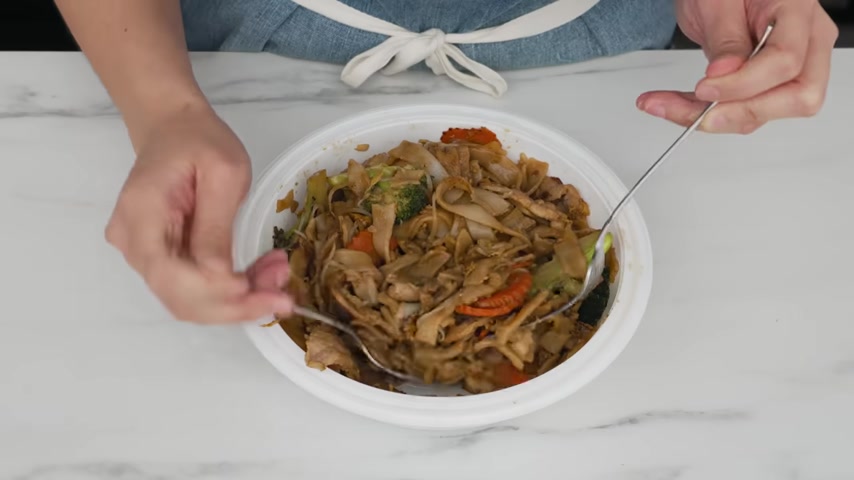
So at welcome to Thai kitchen .
So maybe this has happened to you , you order or you try to make it but the noodles end up mushy and clumpy or maybe it's with fresh rice noodles , but the noodles end up broken into little bits .
Or you go to an Asian grocery store , you look at all the rice noodle options and your eyes glaze over because you have no idea which to choose for which dish or how to cook them properly .
Well , in this video , I'm going to answer those questions and more .
I'll give you everything you need to know about rice noodles , all the different kinds , all their quirks and how to prepare them so that you will have perfectly cooked noodles every time .
Let's get started first .
What exactly are rice noodles ?
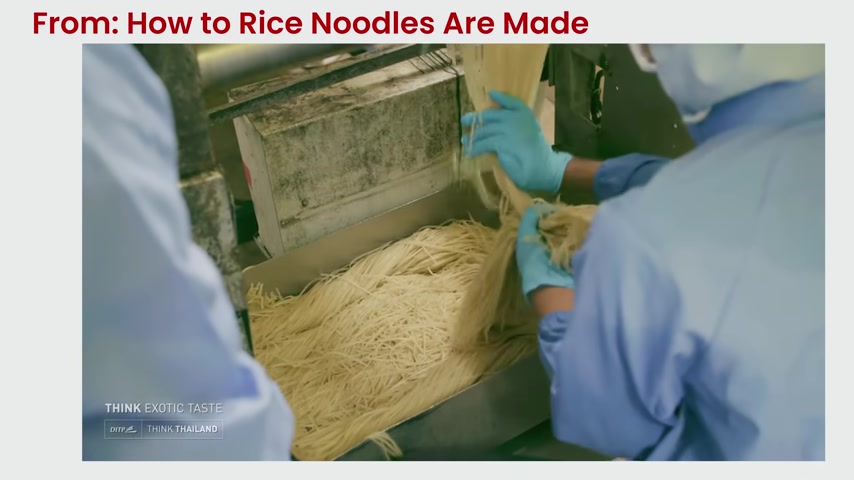
Well , the dried rice noodles are actually not all that different from each other in a sense that they're all made from ground up rice with nothing else , no seasoning added and then they're just cut or extruded in different shapes .
Now , I actually have a really cool video where I give you a tour of a rice noodle factory in Thailand .
I'll link to below .
You got to check it out fresh rice noodles , however , are a little different .
They usually have other starches mixed in and usually some preservatives because rice flour alone would make these a little too delicate .
Now , unlike wheat based noodles , rice noodles are not chewy , they're quite tender , which also makes them trickier to work with because they can go from cooked to overcooked very quickly .
Now , let's go through all the different types of dried rice noodles .
On the smallest end of the scale , we've got rice vermicelli which is send me in Thai .
Now , this is not to be confused with Vietnamese rice vermicelli , which is much bigger and we'll talk about that .
At the end .
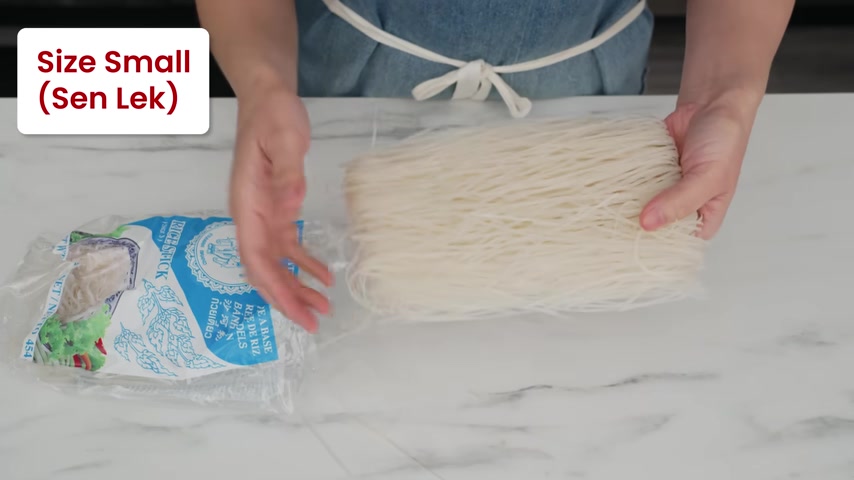
Next up , we have size small , which in Thai is called and it is my preference for all kinds of noodle soups such as F or Thai boat noodles .
Then we've got the medium size , which is the most popular size for noodle stir fries like Thai .
And in fact , in Thailand , we call this .
Then we've got this large size , which is actually not a size that I see in Thailand .
Uh some people like to use it for Pat Thai .
But I do wonder if it's an export only size because people like things to be bigger here .
Then we've got this extra large size , which doesn't actually exist in Thailand because these are meant to be a substitute for these fresh wide rice noodles that are so popular in and drunken noodles .
But these can be hard to find because they're highly perishable .
So these are the shelf stable substitute .
Now , let's talk the best noodles for the job for noodle soups .
You wanna go small , anything from the vermicelli up until medium size is fine .

And here's why , as I mentioned , these rice noodles have no flavor whatsoever .
There's no seasoning , no salt in it .
So the more surface area you have for the broth to cling to the more flavorful that mouthful becomes if you go too large , each mouthful is just gonna feel like a lot of noodles and not enough flavor .
Fresh noodles are the exception to the rule because fresh noodles are more delicate , they're not quite as dense .
So these can work if they are not made too thick , which will vary from brand to brand in Thailand .
We actually have two types of these fresh noodles .
One for soup , which is thinner and more delicate for reasons we talked about and then one for stir fries which are made to be thicker and sturdier .
So they don't break quite as easily when you stir fry them in the wok .
Most of us in North America don't got any choice .
So what you get may or may not work in soups , you just gotta try .
The good news is anything can work for stir fry .
So it really comes down to your preference for the texture .
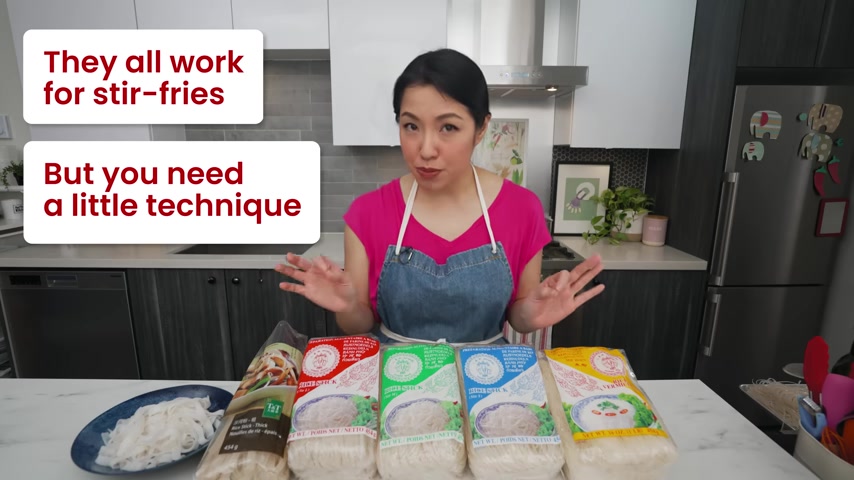
But a lot of people have problems because if you don't know how to prepare them , they come out soggy , mushy , broken into bits and here's why and how to avoid it .
The number one reason your noodles stir fries are a mess is because you are cooking them before you are cooking them .
Here's what I mean , some people boil these and cook them to perfection and then they put those cooked noodles into the wok and then you add sauce which has liquid and then the meat has liquid , the vegetables give off liquid .
And so if the noodles go in already fully cooked , then it's no surprise that they overcook .
Once all the extra liquid has been added , right ?
This is not an issue with egg noodles because they do not overcook nearly as quickly .
In fact , when stir frying with egg noodles , you want them fully cooked before going into the pan because they're not going to cook with just the liquid from the sauce and the veggies .
And yes , I know that the package instructions tell you to boil these .
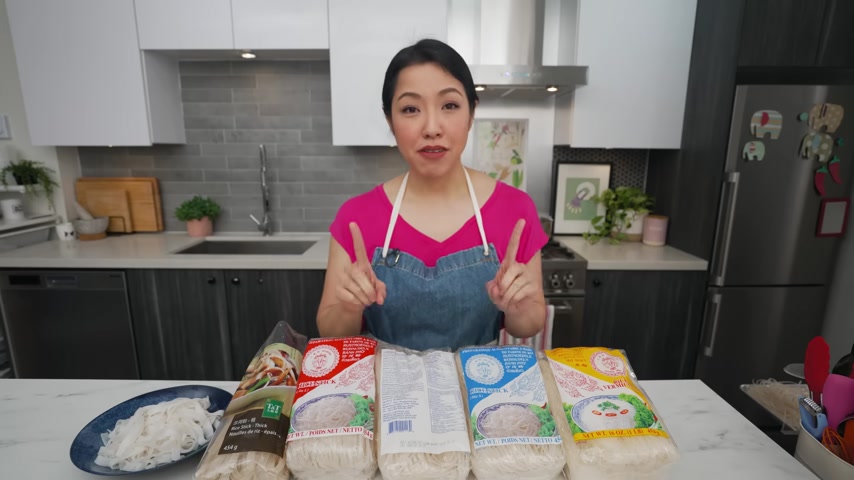
But here's a pro tip that will be useful for the rest of your life .
Never trust the package instruction , the package inst instructions , never trust package instructions on Asian products .
Ok ?
I'm not saying they're all wrong .
I'm just saying you never know which one is correct .
Let me prove my point .
So on the small size noodles , it says to boil the noodles for 6 to 8 minutes .
What does the medium size say ?
What do you know , boil the noodles for 6 to 8 minutes .
What about the large ones ?
Boil the noodles for 6 to 8 minutes .
How is it possible that all these different sizes of noodles take exactly the same amount of time to cook ?
Right .
What you need to do instead is to simply soak them until they're fully rehydrated and then let them cook in the pan .
Here's how to properly soak them .
The best practice is to use room temperature water .
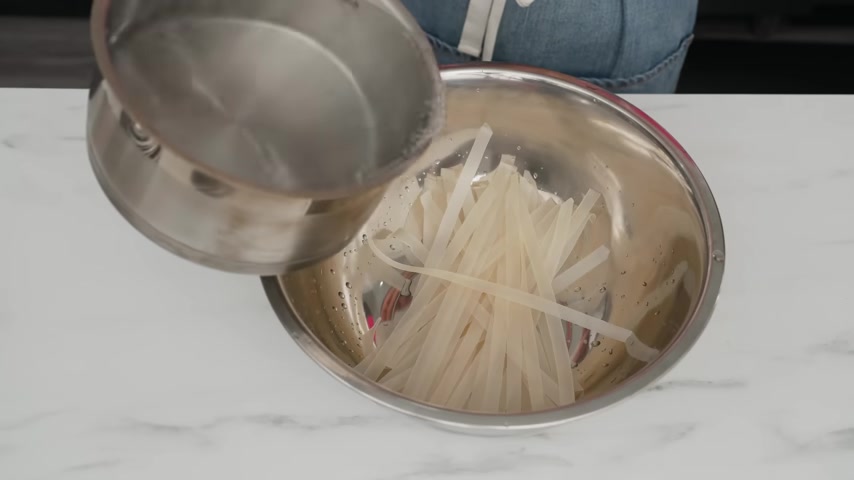
Rice will take 5 to 15 minutes depending on the brand small size , about 20 to 30 minutes , medium size will take 50 to 60 minutes .
Large size takes 90 minutes to two hours .
And the extra large size is a bit of an exception because they are supposed to be a substitute for these fresh noodles .
And therefore , what I do is I use hot off the boil water .
I soak them for 15 minutes .
You want to be stirring them quite often in the beginning to prevent them from sticking to each other and then drain and rinse under cold water and they're going to end up partially cooked .
By that point , the timing is just a guideline .
Different brands will vary a little bit .
Here are some noodles that have been soaked and ready to go into the pan .
And the reason that you want to soak them rather than boil them like spaghetti is because as I said , rice noodles overcook very easily .
So by soaking them , you allow them to evenly hydrate all throughout .
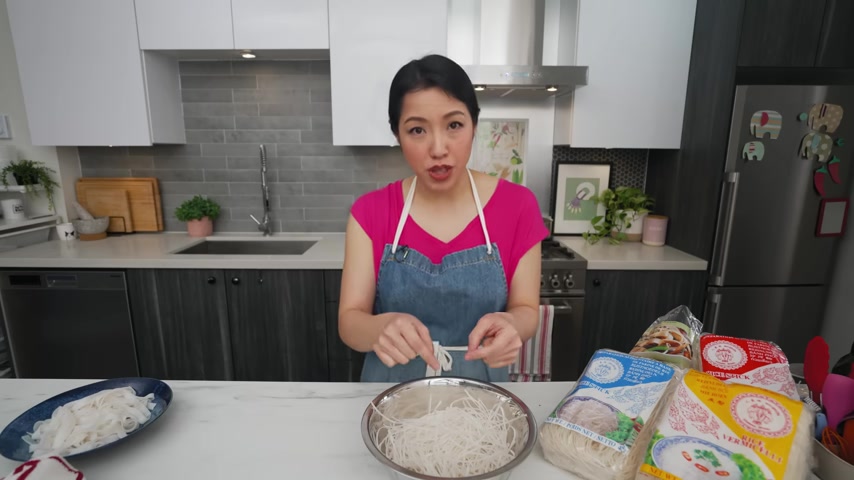
And then the heat from the pan will cook them using the water that's already in the noodles .
The result is even cooking and a very low chance of over cooking them .
So the important question is , how do you know when the noodles have soaked enough ?
Well , all you have to do is pick up the noodles and they should droop completely , not resisting gravity at all .
If they're kind of trying to hold on to their original shape , they are not ready .
These are now ready to go into the wok or a pan and they'll usually need a little bit of extra liquid to help them finish cooking .
How much liquid depends on a lot of factors , including how much liquid is already in the sauce .
How much are you crowding the pan ?
How much meat and vegetables and all that stuff .
So it's best to just follow a trusted recipe before you start winging it .
And if you are gonna wing it a little water at a time and then taste and then add more water only if needed .
This is how prevent soggy noodles .
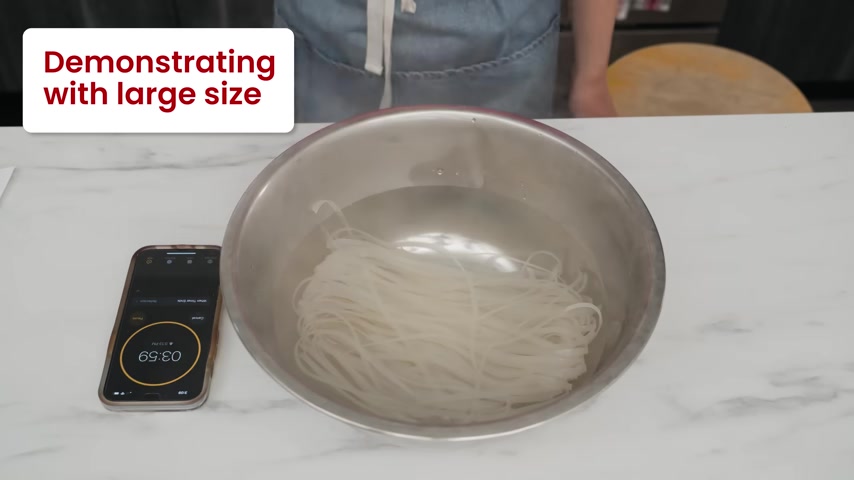
But what if you forget to soak the noodles , which sometimes happens and that's why I have an emergency soaking solution for you .
You can use hot off the boil water and soak the large size for four minutes .
Medium size for three and small size for two and then drain them immediately under cold water .
It's not ideal but it will work in the pinch .
And I would not risk this method with the rice vermicelli .
But these don't take long anyway .
Room temp is my salt .
It because it's so hard to over soak these at room time that you don't even have to set a timer .
Just check on them every once in a while .
If you are using these for soups , follow the exact same soaking instructions .
But you want to blanch them in boiling water in a meadow sief or noodle strainer so that you can remove them from the water quickly .
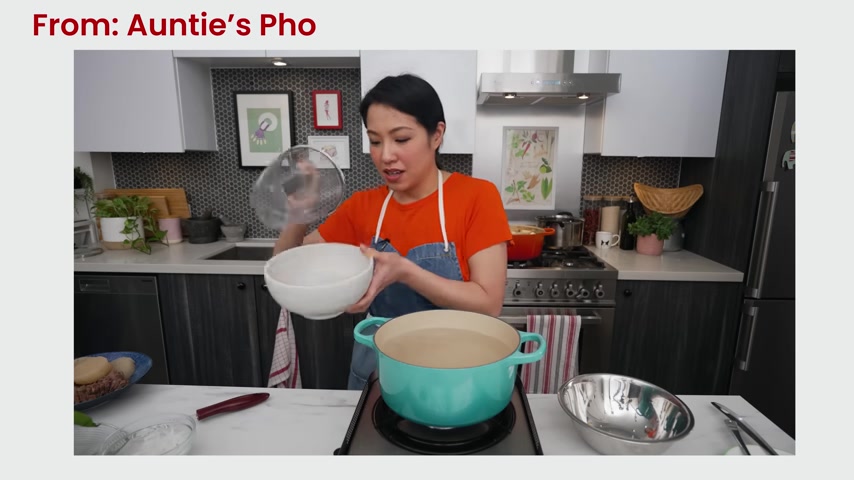
Rice vermicelli will take literally three seconds , small size will take five seconds and the medium size eight seconds when you cook noodles for soup , you want them to come , come out slightly underdone because remember you're gonna pour hot boiling soup over them .
So they're going to continue to cook in the bowl .
And again , timing will vary slightly between brands .
Now let's talk fresh rice noodles , fresh white rice noodles like what you see in pat or drunken noodles .
These are also called noodles and you can find them at many Asian grocery stores in a pack like this usually next to all the tofu .
Now this is a fresh high perishable products .
So usually these are made locally , which means what you get from city to city even store to store is going to vary significantly in terms of width and thickness and , and even the actual texture of the noodles .
What I can get here is actually not ideal .
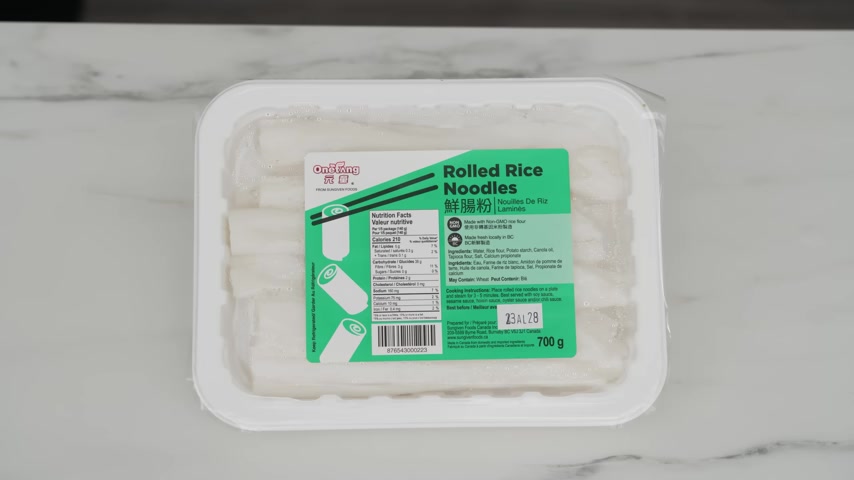
I find it a little too skinny , a little too thin , too delicate , but better than nothing .
I guess these are not to be confused with these rice noodle , which look very similar , but these are actually meant to be eaten as is with some sauce .
You might have had these at Dim Sum restaurants .
And I want to mention this because some people have gotten confused and thought that you were supposed to take these unroll them and then cut them into noodles , which in theory you can .
But trust me , it does not work well because these are actually thinner than these noodles .
And it's , it just doesn't work .
Just trust me on this because this is not confusing enough .
We're going to introduce yet another kind of fresh rice noodles .
Now , this is basically an equivalent of the pre soaked dried rice noodles .
OK ?
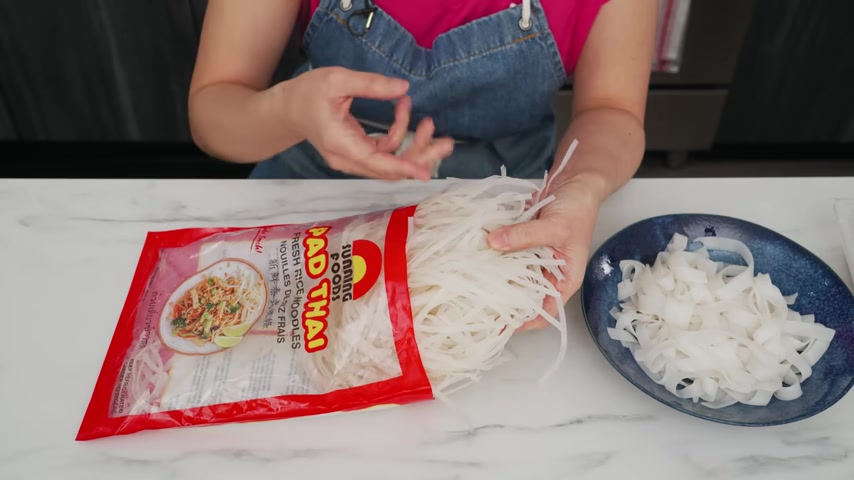
This is what restaurants would use for their thi this is what we use in Thailand because it's convenient .
You can just throw this into the pan .
You don't need to soak it , but it's not shelf stable , right ?
And if you have access to this , you will treat this in the same way as pre soaked noodles .
So you can throw this directly into the pan for stir fries with a little bit of extra , no extra water or you blanch them quickly in boiling water for soups .
Here's the million dollar question .
How do you cook these delicate fresh rice noodles without turning them into broken little bits in the pan ?
Well , here's what you do .
You want to peel apart the noodles before cooking .
But if they're cold and stuck together like this , you want to heat them up first .
So separate them into chunks .
best you can and spread them out on a plate .
Microwave them for about a minute , take them out and see if you can separate them into even smaller chunks and sort of rearrange them for even heating .

Microwave them again for another minute and repeat this until the noodles are soft enough to be individually peeled apart and no , there is no quick way of doing this .
Ok ?
So I'm gonna give you a quick demo of how to stir fry these rice noodles without turning them into bits .
First choice of utensils , matters ones are better because they are less sharp .
These metal spatula are like blades to the noodles .
So you're gonna be more prone to accidentally chopping the noodles two .
You want your pan to be either a well seasoned wok or a non stick surface because these noodles love stick .
And if you're having to scrape them off the pan , then you're definitely going to break the noodles .
Now , I'm gonna turn my pan on for the next tips .
So I am making .
Of course , I've got my garlic , my eggs and my vegetables already in .
And this is when you would add the noodles .
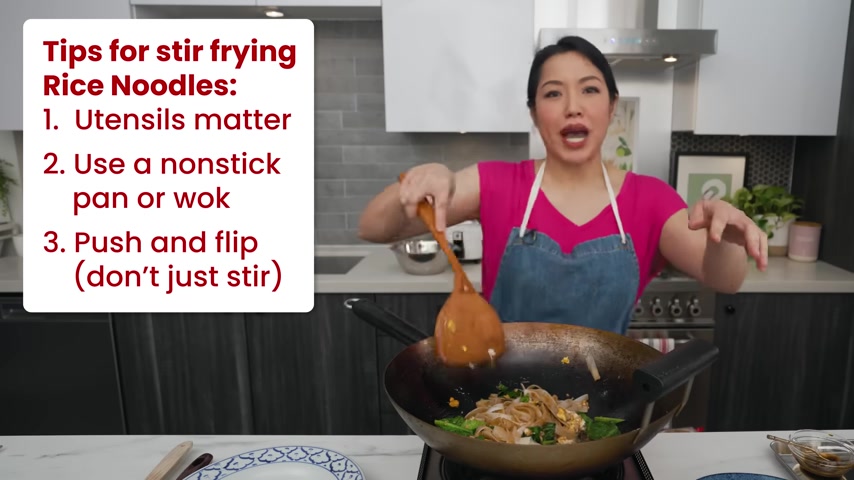
So the noodles go in and also the sauce and the sugar .
Now , tip number three , once the noodles are in , you want to push or flip the noodles , right ?
Push or flip rather than just randomly stirring them .
Because if you're just randomly stirring , there's a chance you can chop the noodles .
So pay attention to the movement that you're using .
And if at all possible , if you have the skills toss , avoid the utensils altogether and then give them a flip , give them a toss much easier done in a lighter pan .
Finally , this is one portion of TCU .
And then in my recipe , I always tell people cook one portion at a time .
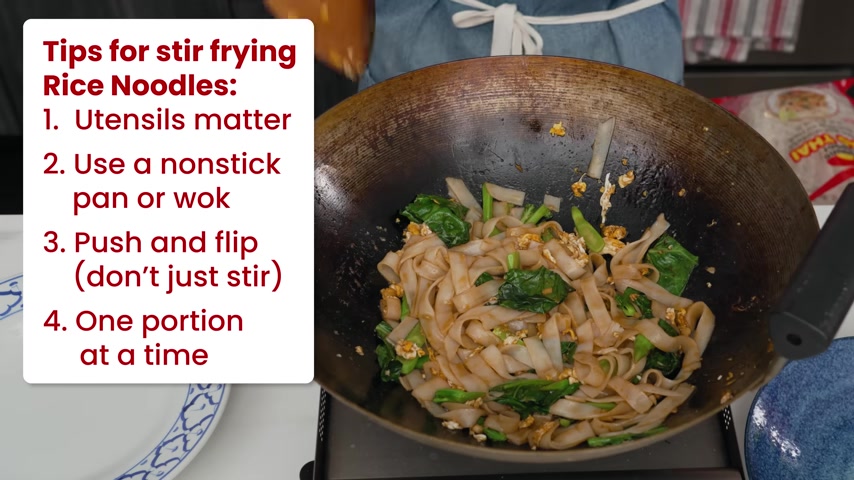
And the reason is because if you have a lot of noodles , you're going to have to stir more , which then risk cut the noodles .
And also you're going to trap a lot of moisture .
And remember these noodles are fully cooked , any excess moisture will cause them to overcook and swell .
OK .
So these are the five tips that will help you not end up with broken bits .
And also if you don't crowd the pan , you will get nice noodle charring like this .
And finally , some brands of noodles are just more delicate than others .
If you have tried everything and you're still struggling .
If you've got options , maybe seek out another brand and also the dried noodles .
Um the extra large shelf stable version , those are much less likely to break .
They don't taste as good .
They don't have as good of a texture .
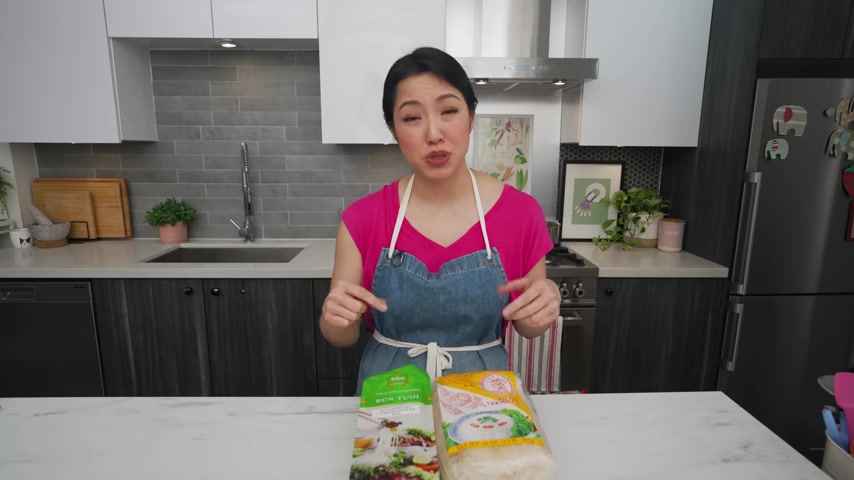
But if this is just not working for you , maybe give those a try .
Yeah , see and now we've got beautiful noodles that still look like noodles one more thing .
And then I'm done .
I promise I want to talk about Vietnamese rice noodles , which often add to the confusion when people are shopping Vietnamese rice vermicelli are not the same as Thai rice vermicelli .
So you need to check the country of origin before you buy Vietnamese ones are much thicker round noodles .
And you often see in the Vietnamese fresh spring rolls and the way you cook these is you cook them like pasta , you boil them in water and then you drain them , dunk them into cold water to stop the cooking and then rinse off excess starch .
And then there are a few things you can do with them .
You can make a noodle salad , you can pour a sauce over it like we do in Thailand .
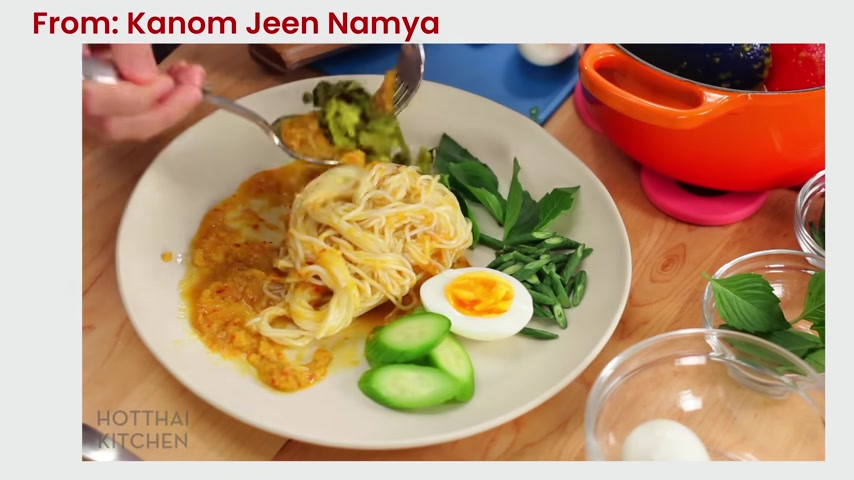
Like in my recipe , you can check that out or you can make wraps like the fresh spring rolls or I make a macro lettuce wrap with them .
It's really good , but generally these do not get cooked any further .
Meaning you don't throw this into a wok and make a stir fry probably because they're clumpy and super hard to stir fry with .
It's just not gonna turn out .
Well , finally , these Vietnamese tapioca sticks , which look almost exactly like the Thai medium sized noodles .
Except they actually have rice flour and tapioca starch mixed in .
They're made for a specific kind of Vietnam rice noodles .
And the tapioca gives the noodles a clear uh look and also a chewier texture .
You do prep them in the same way , but the texture is different .
So if you want to try it out , go ahead , just know that these are not the same and that is it .
I'm gonna plug my mini documentary one more time .
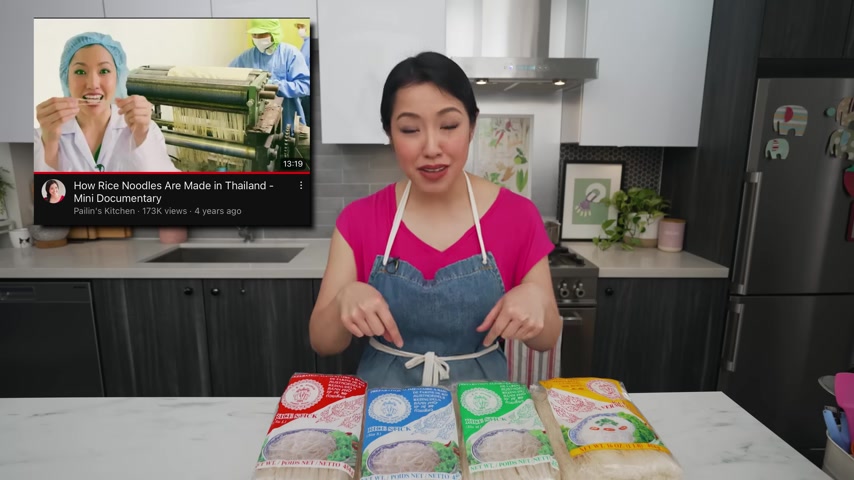
If you want to see how rice noodles are made in a factory in Thailand , check out that video , I'll link in the comments below .
And if you have any questions that somehow I missed in this video , please leave them in the question in the comments as well .
A special thanks to all of our Patreon members who help support the show .
If you want to know what that's all about , how to get direct access to me and watch my videos at free .
Check out the link in the description below .
Thank you as always for watching and I will see you next time .
So at
Are you looking for a way to reach a wider audience and get more views on your videos?
Our innovative video to text transcribing service can help you do just that.
We provide accurate transcriptions of your videos along with visual content that will help you attract new viewers and keep them engaged. Plus, our data analytics and ad campaign tools can help you monetize your content and maximize your revenue.
Let's partner up and take your video content to the next level!
Contact us today to learn more.